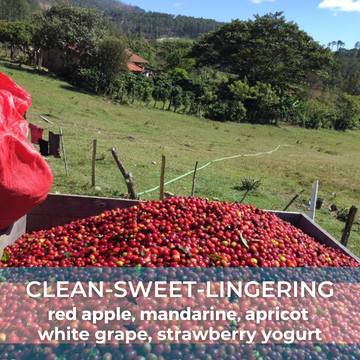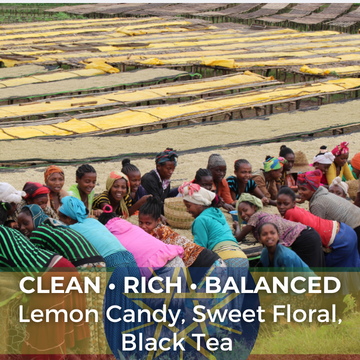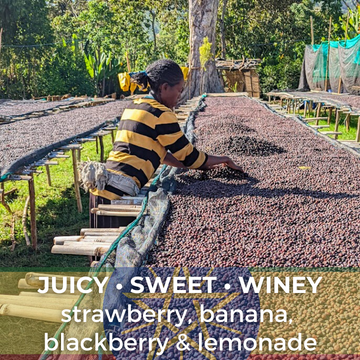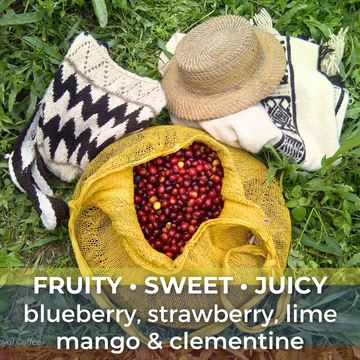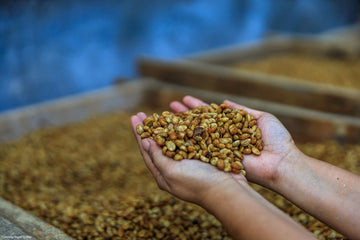Fresh Roast SR540 and SR800 Tutorial
Enjoy a beginner's guide we put together for the SR800 (which also applies to the SR540). If reading is more your style, see below for our compendium of tips! If you'd prefer to watch the video in YouTube, click here: https://youtu.be/Ck5XUPlRPh8
IMPORTANT!
THESE ROASTERS ARE VERY TOP HEAVY. BE CAREFUL WHEN MOVING THEM AROUND. THE CHAFF COLLECTOR IS ONLY HELD ON BY GRAVITY AND CAN FALL TO THE FLOOR AND BREAK QUITE EASILY.
These roasters are called “fluid bed” roasters. In this case, hot air is the fluid. This differentiates them from convection type drum roasters. The flow of hot air roasts the beans, keeps them agitated to prevent scorching, and blows the chaff into the collector. They are easy to use and fast.
Read the manufacturer’s instructions! These are supplemental tips, not a replacement for reading the manual that comes with your roaster.
Here are a few additional tips:
- There will be some smoke as the roast progresses, so develop your strategy for dealing with it before you begin. It’s negligible in the lighter roasts and more pronounced in the darker roasts. Roast under a range vent, by a window, on the porch, or how ever you think best for your situation. Smoke is a natural part of roasting as the sugars in the bean begin to caramelize. The smoke is negligible in the lighter stages and increases in the darker profiles. Just be aware of it. Don’t leap to start cooling the beans at the first sign of smoke, but have a plan to deal with it. It will set off a smoke alarm.
- Put the correct amount of green coffee in the chamber. This is important since you depend on the beans to restrict the air flow somewhat, allowing your roaster to reach optimum roasting temperature. Place the chamber in the base, put the chaff collector on top.
- When you turn your roaster on, it defaults to 5.9 minutes. There is nothing magic about that number. Use the “up” button to increase your roasting time. Most medium dark to dark roasts take about 10 minutes, perhaps more, depending on the ambient temperature. Watch your coffee and press the “cool” button as it approaches your preferred roast darkness. Although the machine will automatically enter the cooling cycle at the expiration of the roast time, they are NOT automatic machines. Don’t depend on that automatic switching. Set the roast time for more than you’ll need and manually initiate the cooling cycle.
- Begin the roast with the temperature setting low, and the fan speed as high as possible (turned fully clockwise). Green coffee contains a lot of moisture which makes the beans heavy. You want to agitate the beans heavily until some of that water cooks off, lightening the beans so that they churn more easily in the roasting chamber. If they do not move enough, they will scorch – not a good taste.
- Watch the beans. In a few moments they’ll begin to turn yellowish, and begin to agitate. This is the “warming/yellowing” phase when the beans are losing moisture. You will notice them going from green to yellow. You will also begin to smell a wet grass or wheat smell. Remember, roasting coffee is a full sensory task that requires your attention!
- As your roast progresses, you should decrease the fan speed and increase the power setting. This will allow the temperature to build in the roast, pushing the beans into the next stage (first crack). Remember: the fan speed affects temperature AND agitation. It’s a trade off. High fan speed keeps it cooler, but agitates the beans more and vice versa.
- Soon the beans will noticeably swell, and you’ll hear a popping sound. It sounds a lot like popcorn. You will also notice that there is more smoke, and the smell is different. The wet grass smell is gone, replaced by a oily smoke smell. You may notice the change in smell before you hear first crack. It really starts to smell like roasting coffee – smokey, sweet, and oily. This is called “the first crack”. Now the beans begin to darken, and things will start happening very quickly so really pay attention to your beans at this point.
- Once first crack is underway, you want to extend this development time by not adding too much heat right away (skipping straight to second crack) while also not stalling the roast (beans never get enough heat to reach second crack). This fine balance takes practice! While first crack is well underway, consider leaving your fan speed where it was when you entered first crack and only increasing the power setting for a small adjustment. As first crack winds down, now decrease your fan speed once more to encourage momentum to second crack.
- Once first crack happens, you officially have drinkable coffee. Now you have to decide how dark to carry your roast to determine how that cup will taste.
- Only you can decide how dark to roast your coffee. The darker it is, the more it begins to lose the nuances of the varietal type and acquire the character of the roast. Most people when they first start home roasting tend to go a little dark. Not that it makes bad coffee—it doesn’t! Play around. Roast the same coffee to various profiles and find the one you like best.
- Shortly after the first crack, the beans enter the stage known as “the second crack”, a more rapid “Rice Crispies” type crackling. They begin to become shiny as oil migrates to the surface. At the very beginning of the second crack is the stage we call “
Full City - If your coffee approaches the roast profile you prefer before it automatically reaches the cooling cycle, manually activate the cooling cycle and allow the beans to cool in the chamber. Roasting is not linear. It accelerates in the later stages. Anticipate, and begin to cool the beans just prior to reaching the desired profile.
- Now comes the hard part—waiting! After the beans have cooled, put them in an airtight container (we use old fashioned canning jars with the latch and rubber seal) and wait 4-24 hours (some coffees actually become more mellow in the 48-72 hour range) before grinding and brewing. Again, experiment and find the time period you think is best. Of course you can grind/brew right away; we do it all the time. But the flavor of the beans will continue to develop if you’ll wait. The beans continue to off-gas for quite a while after roasting (mostly CO2). Remember, after your beans are roasted, oxygen is their worst enemy. Keep them sealed, and out of direct light until ready for use. Think of roasted coffee like you would a loaf of fresh bread. Treat it the same way—keep it away from oxygen. Roasted coffee stored in this manner may be considered “fresh” for about 5 days. Always grind immediately before brewing. Ground coffee begins to stale in only minutes. We don’t recommend refrigerating or freezing roasted coffee. Remember, Freshness! Roast just what you’ll use soon.
Empty the chaff collector after every batch.
Always allow the cooling cycle to complete, not just for the sake of the beans but it is good for your roaster.
Experiment--blend, change roast profiles, and have fun. And enjoy some really excellent coffee.
Don’t be overly obsessive about “roast profiles”. You’ll discover soon what you like best. While we prefer a lightly roasted Ethiopian Harar, you might want it done to a Full French Roast. Vary the profile for each coffee until you find what you like best. Try roasting the same coffee dark in one batch and then light in the next, and then blend the two for a really great, yet different cup. The main thing is: enjoy!
Additional information is available in the “Learning Center”. If you have any questions at all, drop us a note and we’ll get back to you with an answer as quickly as we can.
Happy Roasting!
